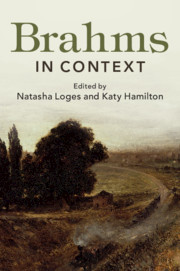41 results
Music Examples
-
- Book:
- Brahms in Context
- Published online:
- 15 May 2019
- Print publication:
- 09 May 2019, pp xiii-xiii
-
- Chapter
- Export citation
Index
-
- Book:
- Brahms in Context
- Published online:
- 15 May 2019
- Print publication:
- 09 May 2019, pp 395-408
-
- Chapter
- Export citation
Chapter 39 - Mythmaking
- from Part V - Reception and Legacy
-
-
- Book:
- Brahms in Context
- Published online:
- 15 May 2019
- Print publication:
- 09 May 2019, pp 384-392
-
- Chapter
- Export citation
Contents
-
- Book:
- Brahms in Context
- Published online:
- 15 May 2019
- Print publication:
- 09 May 2019, pp vii-x
-
- Chapter
- Export citation
Part II - Identities, Environments and Influences
-
- Book:
- Brahms in Context
- Published online:
- 15 May 2019
- Print publication:
- 09 May 2019, pp 69-184
-
- Chapter
- Export citation
Illustrations
-
- Book:
- Brahms in Context
- Published online:
- 15 May 2019
- Print publication:
- 09 May 2019, pp xi-xii
-
- Chapter
- Export citation
Further Reading
-
- Book:
- Brahms in Context
- Published online:
- 15 May 2019
- Print publication:
- 09 May 2019, pp 393-394
-
- Chapter
- Export citation
Chapter 30 - Science and Technology
- from Part IV - Society and Culture
-
-
- Book:
- Brahms in Context
- Published online:
- 15 May 2019
- Print publication:
- 09 May 2019, pp 296-304
-
- Chapter
- Export citation
Preface
-
-
- Book:
- Brahms in Context
- Published online:
- 15 May 2019
- Print publication:
- 09 May 2019, pp xxiii-xxv
-
- Chapter
- Export citation
Part III - Performance and Publishing
-
- Book:
- Brahms in Context
- Published online:
- 15 May 2019
- Print publication:
- 09 May 2019, pp 185-256
-
- Chapter
- Export citation
Abbreviations
-
- Book:
- Brahms in Context
- Published online:
- 15 May 2019
- Print publication:
- 09 May 2019, pp xxvi-xxviii
-
- Chapter
- Export citation
Part I - Personality, People and Places
-
- Book:
- Brahms in Context
- Published online:
- 15 May 2019
- Print publication:
- 09 May 2019, pp 1-68
-
- Chapter
- Export citation
Notes on Contributors
-
- Book:
- Brahms in Context
- Published online:
- 15 May 2019
- Print publication:
- 09 May 2019, pp xiv-xxii
-
- Chapter
- Export citation
Copyright page
-
- Book:
- Brahms in Context
- Published online:
- 15 May 2019
- Print publication:
- 09 May 2019, pp iv-iv
-
- Chapter
- Export citation
Chapter 32 - England
- from Part V - Reception and Legacy
-
-
- Book:
- Brahms in Context
- Published online:
- 15 May 2019
- Print publication:
- 09 May 2019, pp 316-323
-
- Chapter
- Export citation
Part V - Reception and Legacy
-
- Book:
- Brahms in Context
- Published online:
- 15 May 2019
- Print publication:
- 09 May 2019, pp 305-392
-
- Chapter
- Export citation

Brahms in Context
-
- Published online:
- 15 May 2019
- Print publication:
- 09 May 2019
Chapter 14 - Private Music-Making
- from Part II - Identities, Environments and Influences
-
-
- Book:
- Brahms in Context
- Published online:
- 15 May 2019
- Print publication:
- 09 May 2019, pp 130-137
-
- Chapter
- Export citation
Part IV - Society and Culture
-
- Book:
- Brahms in Context
- Published online:
- 15 May 2019
- Print publication:
- 09 May 2019, pp 257-304
-
- Chapter
- Export citation
Dedication
-
- Book:
- Brahms in Context
- Published online:
- 15 May 2019
- Print publication:
- 09 May 2019, pp v-vi
-
- Chapter
- Export citation



